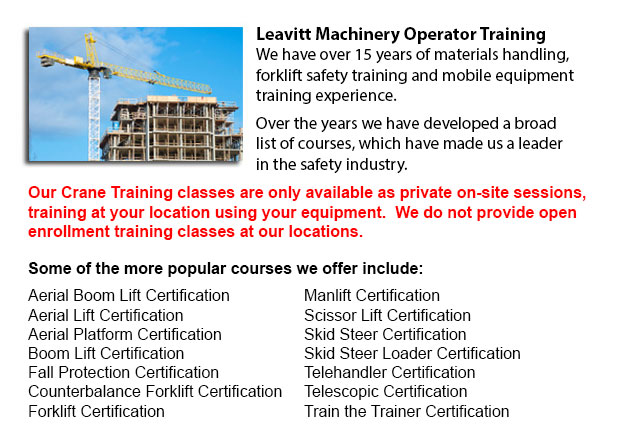
Overhead Crane Operator Training Langley - The course teaching overhead crane operator training has been intended specifically to instruct trainees on the fundamentals of pre-shift checks and overhead crane/sling operation. The courses are instructed by expert trainers and consultants. Well-trained employees are more productive and efficient, which really saves on costs associated with property damage, product damage, and accidents because of the utilization of improper operating procedures. Our overhead crane certification is customized for employees who have literacy barriers, reducing certification time by 50 percent.
The overhead crane has been made to be used doing repetitive hoisting activities. This particular type of crane could be used in many capacities. They can be utilized for specialized hoisting jobs like for instance removing or installing major plant machinery.
To safely operate an overhead crane, workers should employ safe rigging practices. This requires both knowledge and practice. The load should be rigged correctly in order to guarantee its stability when hoisted. Prior to starting a hoisting job, it should be determined that the crane is right for the task, with appropriate travel, lift and capacity. The crane needs to be subjected to a thorough visual and physical check before utilization. The capacity of all machines, including the rope, slings and hardware, should never go over load weight capacities.
Before utilizing the rigger needs to know what sling is right for each lift and must check the rigging gear and hardware. The communications that are used with the crane operator must be concise and clear. A signaler needs to be designated for the role and signals must be agreed upon. The crane operator has to follow instructions only from the designated individual. If a wired or remote controller is being utilized, the operator must be trained in all its functions.
Before whatever lifting begins, the path of the load must be cleared of all obstructions and a warning sign must be issued to be able to guarantee the safety of the employees. Pedestrian are not under any circumstance allowed to walk under the lift loads. The crane hoist needs to be centered over the load before hoisting to prevent swinging. The safety catch must be closed immediately after sliding the sling entirely onto the hoisting hook. Unused sling legs should be secured so they do not drag. Never leave loose materials on a load being lifted. Watch that fingers and hands are clear when slack is taken out of a sling. Before the lift is made, step clear of the danger zone.
-
Boom Lift Certification Langley
Boom Lift Certification Langley - Making use of elevated work platforms allow for maintenance operations and work to be performed at elevated work heights which were otherwise unreachable. Boom Lift Certification Training educates workers about safel... More -
Boom Lift Training Langley
Boom Lift Training Langley - Elevated work platforms, likewise referred to as aerial platforms, enable workers to carry out tasks at heights which would otherwise be unreachable. There are various types of lifts intended for various site applications... More -
Wheel and Track Loader Training in Langley
Lift trucks are available in a variety of various units that have varying load capacities. The majority of typical lift trucks used in warehouse settings have load capacities of 1-5 tons. Larger scale models are used for heavier loads, like loading s... More -
Counterbalance Forklift License Langley
Counterbalance Forklift License Langley - When operated by completely trained operators, forklifts could become a major advantage for firms and companies. We can offer your employees a thorough training program which consists of all factors of operat... More -
Aerial Lift Ticket Langley
Aerial Lift Ticket Langley - A boom truck is frequently recognized by the cable and telephone company vans that have the elongated arm folded over their roofs. Commonly, a bucket-like apparatus sits at the extension of extendable arms. Often termed a... More -
Aerial Lift Training Langley
Aerial Lift Training Langley - An aerial work platform is a mechanized access platform. This particular device provides access to otherwise not accessible places for equipment or people. Likewise known as an aerial device or elevating work platform,... More -
Wheel Loader Operator Training Langley
Wheel Loader Operator Training Langley - To be able to raise considerable weights, industrial cranes utilize pulleys and levers. In the past, Romans utilized cranes to construct huge monuments making the origin of these equipment at least two thousan... More -
Manlift Safety Training Langley
Manlift Safety Training Langley - It is important for competent Manlift operators to be aware of the connected dangers which come with particular kinds of scissor lifts. They must be able to operate the scissor lift in a way that protects not just th... More

Forklift Training Langley
TOLL FREE: 1-888-254-6157
Langley, British Columbia
forklifttraininglangley.com
Email Us
About Us


